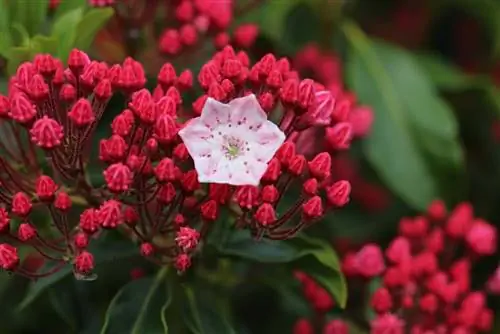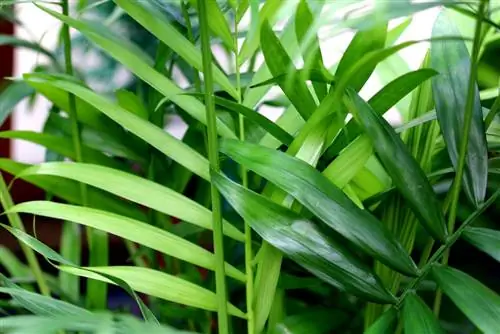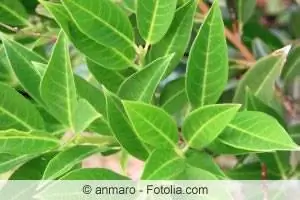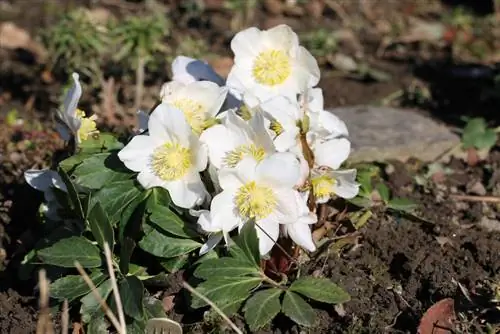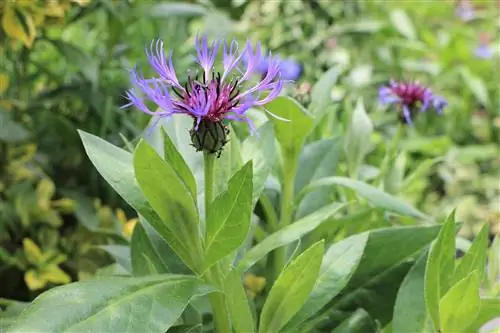- Author admin [email protected].
- Public 2023-12-17 03:39.
- Last modified 2025-01-24 12:45.
In nature, mountain laurel (Kalmia latifolia), which is also called laurel rose because of its pretty flowers, grows predominantly in the mountain forests of North America. There the evergreen shrub grows to over five meters tall. However, it does not reach this impressive height in our latitudes. Its dark red buds form in dense umbels at the tips of the shoots from May onwards and are a feast for the eyes in themselves. During the blooming phase, the cup-shaped flowers change between different shades of pink to a strong red or bright white.
Location
The beautiful laurel rose from the heather family does not require much space because the shrub grows primarily upright and also very slowly. In addition to some varieties that grow up to three meters high, there are also a number of varieties that remain compact and reach a maximum height of one meter. This is why they are particularly recommended for small gardens. A mountain laurel loves semi-shady locations and can be perfectly combined in the garden with rhododendrons or azaleas, whose flowering it follows almost seamlessly. But it also grows in full sun or in shady places. However, avoid the blazing sun in combination with reflected light, for example from large window fronts on southern or southwestern house walls. In the shade, the enchanting flowers lose their bright colors.
- Light requirements: sunny to partially shaded
- sheltered from the wind
- suitable for individual placement or group planting
- beautiful in combination with azalea or rhododendron
- also suitable as a pot plant
Floor
The attractive flowering shrub is not particularly picky about the condition of the garden soil. A humus-rich, permeable and slightly acidic soil is usually sufficient for he althy growth. However, the shrub is not particularly adaptable to extreme soil conditions. An important factor for good growth is moist but well-drained soil. The otherwise undemanding plant does not tolerate drought any more than it tolerates waterlogging. If rhododendrons are already growing in your garden, mountain laurel will also thrive without any problems.
- moist-fresh
- humous and moderately nutrient-rich
- well permeable to water
- acid soil
- pH value: 4.5 to 5.5
- not compatible with lime
- does not grow well in clay or sandy soils
Tip:
If you don't know the pH value of your garden soil, you can buy test strips from stores (garden stores or pharmacies) and use them to easily check your soil. The laurel rose does not tolerate calcareous soil.
Plants
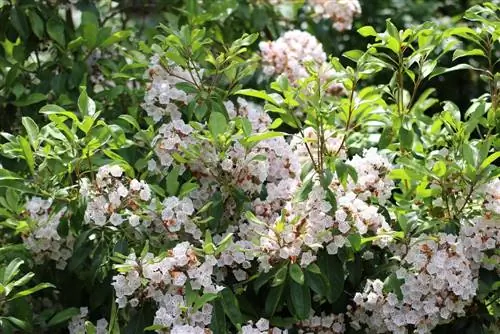
The laurel rose looks particularly good in its own position. But it can also be used as a hedge plant. Azaleas and rhododendrons are recommended as combination partners, with mountain laurel seamlessly following their flowering phase in May, thus providing further splashes of color in the garden. The best time to plant the shrub is either spring or autumn. If soil conditions are not optimal, they should be improved before planting. To do this, an area of at least one square meter and 50 cm deep must be dug up and mixed with the respective components. If you plant several mountain laurel bushes at once, change the soil in the entire bed. The shrub needs a lot of organic, humus-rich soil in which it can spread its roots.
- Time: Spring (April/May) or Autumn (September/October)
- Dig up heavy soils well, loosen them up and add sand, peat moss and compost
- enrich sandy and barren soil with humus or compost and peat moss
- Planting hole: at least three times the width of the bale and twice the depth
- first fill in high-quality plant substrate
- Substrate: humus or compost, sand and peat moss
- Water the root ball well before planting
- Insert the bale and fill with substrate
- Planting depth: as before
- must not be planted too deep
- the point where the trunk meets the roots must be above ground level
- create a watering edge made of garden soil around the planting hole
- come easy
- pour well
Tip:
So that the Kalmia latifolia can grow well, it needs frequent watering at first.
potted plants
The small mountain laurel species such as 'Nani', 'Ostbo Red' and 'Peppermint', which grow very slowly and only reach a height of 1 m, are particularly suitable for cultivation in a plant pot. The bush has relatively shallow roots, but still requires a large pot to grow strong and he althy. Clay pots with saucers are best suited as the material regulates the moisture balance in the root area well. Make sure that these planters are frost-proof.
- use high-quality pot substrate
- must be humic and well drained
- on the other hand, it should be able to retain moisture well
- Mixtures of humus or compost, peat moss and sand are perfect
- alternatively azalea or rhododendron soil
- Plant container should be at least 10 cm larger than the root ball
- first create a drainage made of clay, lava granules or similar
- fill with substrate
- Insert plant and fill gaps with substrate
- pour well
Care
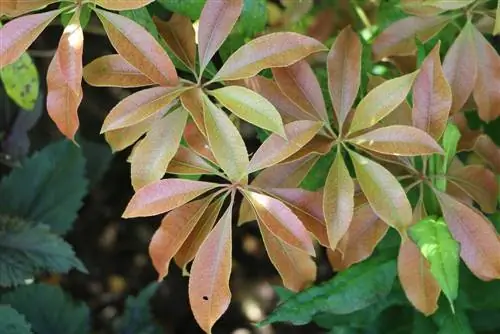
The evergreen shrub with its leathery, shiny leaves is frost hardy and very easy to care for. With only about 5 to 10 cm growth rate per year, there is little risk of the plant becoming too large for its location in a short time. In addition, the kalmia blooms at a young age, so even small specimens from the garden center do not take long to bloom.
Pouring
The mountain laurel does not tolerate waterlogging or dry substrates. The tree has a very shallow root system and requires more watering than most other shrubs in the garden. Watering is necessary more often in a bucket than outdoors. Humus-rich soil can store water better and gradually release it to the shallow roots of the flowering bush. Keep the soil evenly moist and do not allow it to dry out. Watering again is necessary when the top substrate layer has dried slightly. In partial shade, Kalmie is much easier to care for in terms of water consumption.
Tip:
A layer of mulch made of bark or pine needles ensures that the water does not evaporate so quickly and at the same time prevents unwanted compaction and an increase in the pH value into the alkaline range.
Fertilize
On humus-rich substrates, additional nutrients are only necessary after a few years. In poorer soils or plants that are well established at the site, a portion of compost in spring supports the Kalmia latifolia's willingness to bloom and its defenses. It is important not to give the bushes excessive amounts of nutrients, otherwise their leaves will burn and develop a brown edge. Therefore, do not plant a mountain laurel near lawns that you fertilize with products that have high nitrogen contents. Outdoor plants are fertilized in spring, container plants only during the growth phase between April and the beginning of August.
- fertilize cautiously only once a year
- in spring with compost or horn shavings
- do not administer high amounts of nitrogen
- Use fertilizer for acidic soil conditions
- only ¼ of the recommended amount of fertilizer for azaleas and rhododendrons
- Fertilize potted plants with liquid fertilizer for acid-loving plants (once every six weeks at half concentration)
Caution poisonous
The only disadvantage of this almost perfect plant: It is very poisonous in all parts. That's why it is also known as lambkill in English-speaking countries. In the eastern part of the USA, the shrub with the extravagant flowers regularly causes the death of grazing livestock (especially sheep). As a precaution, wear gloves when repotting or pruning the shrub. It is also advisable to dispose of the waste safely so that children or animals do not accidentally come into contact with it.

The poisonous components are found in all parts of the plant, but especially in the leaves. Skin contact may cause redness and a rash that burns or itches. When taken orally, small amounts cause nausea, vomiting, diarrhea as well as increased salivation and dizziness. In the worst case, however, ingestion can also lead to death in humans. It is therefore better to avoid cultivating mountain laurel if small children or animals run the risk of eating the leaves of the plant.
Cleaning up faded flowers
To stimulate the flowering of Kalmia latifolia, wilted plants should be plucked out or cut regularly during the flowering period in May and June. On the one hand, this makes the shrub look more well-groomed, but on the other hand, the plant does not have to put its energy into producing seeds, so it keeps producing new flowers.
Cutting
Otherwise, the very slow-growing laurel rose rarely needs to be cut. Only cut out dead, stunted or diseased wood in winter or spring. If a young plant only branches moderately, bushy growth can be encouraged by careful pruning. Remember that mountain laurel is poisonous and wear gloves as a precaution. You should also dispose of the plucked flowers and the cuttings safely. If pruning is desired or necessary, you should do it in June directly after flowering so that you don't have to miss out on flowering next year.
- no severe pruning necessary
- cut out dry, wilted and diseased branches
- possible all year round
- cut all inwardly growing and crossing branches
- shorten weak shoots at the base
- avoid large wounds
- Prune young plants slightly to improve branching
- best time: directly after flowering
- shorten some unbranched branches by 1/3
- always cut over an outward-facing eye
If the mountain laurel is heavily bare, poorly grown or diseased, you can cut the bush back almost to ground level. However, leave at least one pair of eyes on each shoot so that it can sprout again vigorously. Older plants survive this radical rejuvenation treatment very well, even if they then need about 10 years to return to their original size.
Repotting
Potted plants only regularly need a slightly larger planter when they are young. Check in spring whether the roots have already reached the edge of the pot. If you can see a dense weave on the side or bottom of the bale, it needs to be repotted. The new bucket should be at least 10 cm larger than the old one. Fill in some expanded clay, lava granules or clay shards as drainage and supplement the resulting space with high-quality substrate made of peat moss, humus and sand. Older plants hardly need larger containers, but should occasionally receive fresh soil. Replace part of the old plant substrate approximately every two to three years.
Wintering
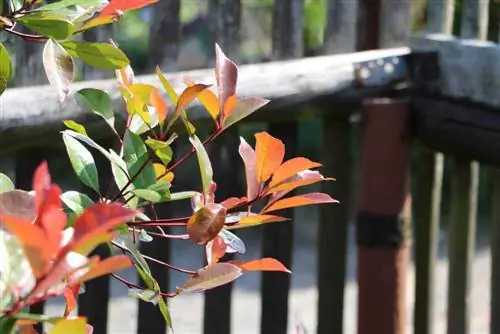
The mountain laurel originally comes from North America and grows in mountain regions under conditions similar to those that prevail here. The plants are therefore absolutely hardy in our latitudes and do not require any protective measures during the cold season. Only young and potted plants are a little more sensitive.
- cover young outdoor plants in the root area with leaves or bark mulch in autumn
- Place the pot in a protected place
- Place the bucket on a Styrofoam plate or wooden block
- Wrap the pot with fleece, jute or foil
- water with caution in winter and do not fertilize
Propagate
Propagate a kalmia yourself is not that easy. Since cuttings rarely root and sowing the different cultivars is not always successful, the only viable option for the hobby gardener is propagation using planters. Only wild forms can be easily propagated from seeds.
- Time for lowering: early summer
- bend a long, slightly woody shoot down to the ground
- draw an elongated channel about 10 cm deep into the ground
- guide the shoot into the ground in the middle up to the outer third
- the shoot tip must look out the other end
- Cover shoots in the ground with soil
- weigh the area with weights (stones etc.)
- Guide the shoot tip upwards on a stick (otherwise it grows crooked)
In autumn at the earliest, but certainly next spring, the shoot will have formed its own roots in the soil and can be separated from the mother plant. If only very few or short roots are visible when checking, it is better to give the shoot a little more time.
Special varieties
Even from a distance, the mountain laurel looks very impressive to the viewer when it is in bloom. However, it only reveals its full delicate beauty upon closer inspection, because each bud and each individual flower is a small work of art in itself. Kalmia latifolia is available in different varieties that differ from each other in their height and flower color:
‘Bandeau’
- Growth height: up to 3 m (also known as large mountain laurel)
- also available as a small version up to 1.2 m high
- Hundreds of pink flowers, some with red speckles
- particularly resistant to fungal diseases
‘Beacon’
- Synonym: Laurel rose 'Beacon'
- Growth height: maximum 150 cm
- bright red to pink flowers
- very robust
- also suitable for rougher areas (cold winds)
‘Black Label’
- Growth height: 2.5 m (one of the largest varieties)
- white flowers with dark ring
‘Eskimo’
- Growth height: 1.5 to 2 m
- rare pure white flower
- good resistance to leaf spot
‘Galaxy’
- Growth height: 1.0 to 1.5 m
- white background with burgundy red dots
- star-shaped flowers
- The flower shape differs greatly from the wild mountain laurel varieties
‘Kaleidoscope’
- Growth height: 1.0 to 1.5 m
- bright, pink flowers with white border
‘Minuet’
- Growth height: maximum 1.5 m
- striking white flowers with an intense red flower edge
‘Midnight’
- Growth height: 1 to 1.5 m
- red-black flowers
- Outside of the flower is white
- very rare variety
‘Moyland’
- Growth height: up to 2 m
- dusky pink flowers
‘Nani’
- Growth height: less than 1 m (grows very slowly)
- white flowers with cinnamon ribbon
- blooms very richly
‘Ostbo Red’
- Growth height: 80 to 100 cm
- strong bright red buds
- open into a light pink flower
- is one of the most beautiful varieties
‘Peppermint’
- Growth height: 50 to 100 cm
- slightly delicate pink flowers
- red lines from the center to the edges
‘Splendens’
- Growth height: 1.0 to 1.5 m
- Flowers with a delicate pink tint
‘Snow Drift’
- Growth height: up to 100 cm
- beautiful pure white laurel rose variety
Diseases and pests
The mountain laurel is one of the robust shrubs that rarely gets sick. Some varieties have been specifically bred for resistance to certain diseases. Occasionally, as with all garden plants, traces of feeding by various butterflies or beetles and their larvae can also appear here.
- brown leaf edges indicate a lack of water or excessive amounts of fertilizer
- drooping, wilted shoots are often the result of waterlogging or a location that is too dark
- If waterlogging occurs, root rot can destroy the entire plant
Conclusion
Unfortunately, the laurel rose with its extravagant flowers is rarely found in our gardens and parks. This may be due to the toxicity of the flowering shrub. Because eating parts of plants can lead to the death of humans and animals. Grazing animals in particular are at great risk here. Even though attempts are made again and again to breed non-poisonous plants, if in doubt you should switch to other, non-poisonous plants.

